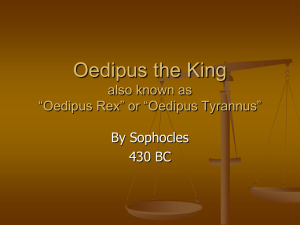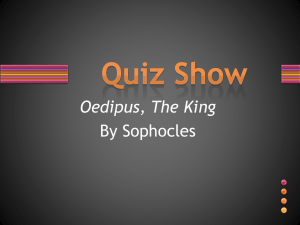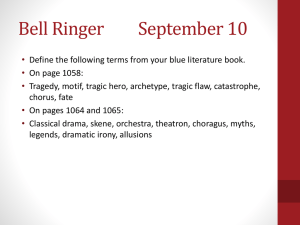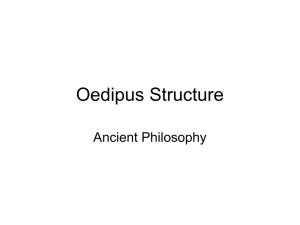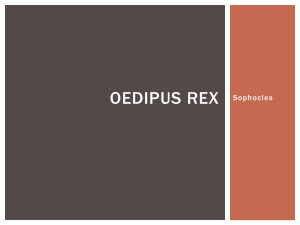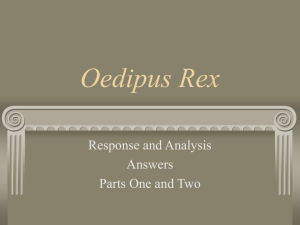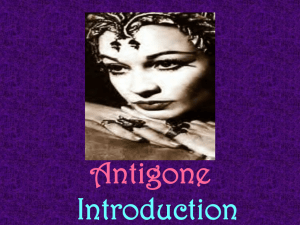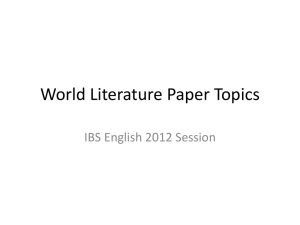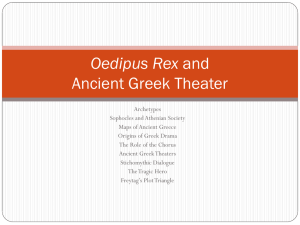戴奧尼索斯是酒神
advertisement
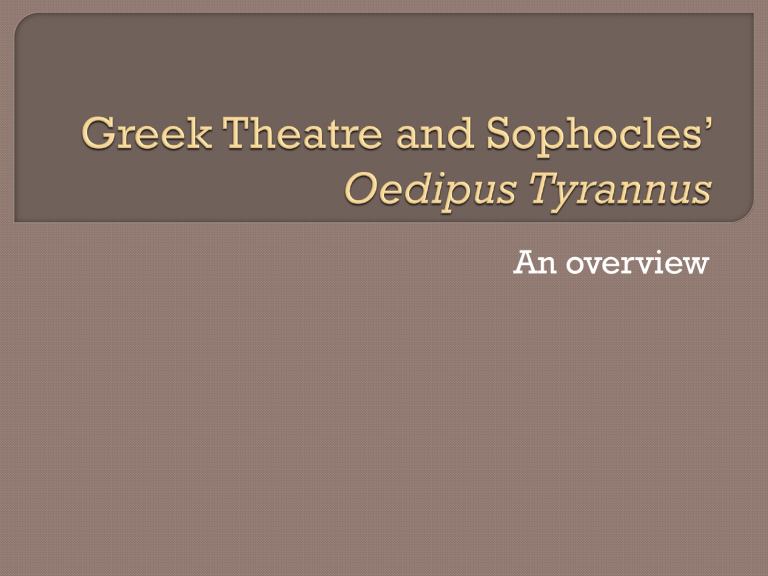
An overview
Athens was at this time a democracy, the
first in Western history.
It was a direct, not a representative,
democracy, for the number of free
citizens was small enough to permit the
exercise of power by a meeting of the
citizens as a body in assembly.
Alice Y. Chang
2
請參考FB討論。
這星期大部分同學都很認真思索這一問題,
提供很多思考的方向,請參考作業觀摩。同
學已經從法治、社會、宗教等面向,並加入
不同的文化與歷史背景作為討論的座標軸,
除此之外,我還想問,是不是也可以從美學
與倫理學的角度思索正義呢?
倫理學,從最基本的人與人之間的平衡開始,
在這基礎下,制定的法規與禮儀就是正義的
展現。
如果倫理的平衡失序,是需要矯正,但是如
何矯正? 是需要有第三者公正立場? 或是其
他可能,作為矯正的依據? 古希臘文學中談
的命運是一例,現代社會呢?
美學的觀點,是動態的,是相對的。首先,
美學的相對前提是,每個人都會有不同的觀
點與角度,所以,美學的平等觀是不看輕任
何人,尊重每個人的視角。第二,美學是動
態的,所以,當一個靜止的狀態,如果必須
加入一個新的元素時,或是一個新的觀點時,
必須允許整體構圖的改變,甚至是重新建立
架構。
Alice Y. Chang
6
Alice Y. Chang
7
An Overview
由演員為觀眾表演故事。說得更簡
單的話:戲劇是由甲扮演乙﹐有丙
觀看。這定義與另一本戲劇史中寫
的一樣:凡能滿足以下條件的就是
劇場(theatre): A represents X while S
looks on.(Fischer-Lichte 257). 甲(A)
是演員﹐乙(X)是故事裡的人
物﹐丙(S)是觀眾。
希臘戲劇是這個主流的源頭。希臘的城邦
之一,雅典﹐從西元前534年起就奠立了悲
劇節,綿延長達三個世紀以上,其間傑作
至今仍為人類瑰寶。戲劇也是表演藝術,
希臘劇場的演出形式及安排,為後世樹立
了一個長青的典型。要了解這份寶貴的遺
產,最好從雅典著手,因為它既是希臘戲
劇的搖籃,也是它的中心。
就人類戲劇史而言,皮氏最大的貢獻,
是他在西元前534年創立了悲劇競賽。
希臘悲劇與宗教儀式有密切的關係。
真正起源已經不可考。現在一般認為起源於
酒神
在祭祀中,合唱隊(Chorus)會表演歌舞祭祀
酒神戴奧尼索斯(Dionysus),這種歌舞被稱
為「酒神頌」 。
「酒神頌」發展到後來,逐漸擴大到神話和
英雄傳說的範圍——悲劇的形式逐步發展和
完善,成為一種固定的敘事體。
他是天神宙斯
(Zeus) 與凡女西蜜莉
(Semele) 生下的兒子,宇斯的妻子希拉
(Hera) 出於嫉妒將他擲入火中,幸被仙女
救出而得重生。
戴奧尼索斯的經歷因此象徵著生命循環
(出生、成長、衰敗、死亡、重生)與四
季交迭(春、夏、秋、冬),希臘人祭祀
他祈求香火傳續,四季豐饒,而身為酒神,
他也常讓人聯想到一些不理性的力量。
古希臘悲劇的表現主題不在於悲劇性的故事本
身,而是在於表現崇高壯烈(sublime and
magnificent)的英雄主義思想。
根據亞裡斯多德Poetics中的定義,古希臘悲劇
「描寫的是嚴肅的事件,是對有一定長度的動
作的摹仿;目的在於引起憐憫和恐懼,並導致
這些情感的淨化;主人公往往出乎意料的遭到
不幸,從而成悲劇,因而悲劇的衝突成了人和
命運的衝突」。
Tragedy= Goat song
The word tragedy literally means
"goat song," probably referring to
the practice of giving a goat as a
sacrifice or a prize at the religious
festivals in honor of the god
Dionysus.
內容:宗教精神、風俗文化
演出場地:天然的露天圓形劇場,圓形
廣場為表演區
ㄧ個演員一個歌隊
Aeschylus
兩個演員一個歌隊
Sophocles
三個演員一個歌隊
早期:
日後希臘戲劇維持為三人,ㄧ人分飾多角
有幾世紀之久,希臘戲劇只在既四戴歐尼色
斯(Dionysus)的節慶中演出。祭祀他是為了
確保春天的復甦。他代表著是上許多非理念
的力量。
在早期的戴歐尼色斯禮拜中,酗酒和縱慾被
視為是宗教衝動的一部分,而加以接受。
雖然這種陋習已經逐漸昇華,但是禮拜中求
取的豐腴的基本目的仍然保存未變。
戴歐尼色斯的崇拜是在西元前十三世
紀左右,自小亞細亞傳入希臘的。
到了西元前第七、第八世紀時,再祭
拜他的節慶中已經有歌隊舞蹈者的競
賽了。隨辦著這些舞蹈的是狂喜的
「戴神頌」(dithyramb),稱戴歐尼色斯。
按照亞里斯多德的說法,戲劇就是由
這些讚美和舞蹈蛻變而來的。
希臘戲劇的第一個確切紀錄見之於西元五三
四年,這一年「城市的戴神節」組織改變,
在各項活動中加入了悲劇演出競賽。
戲劇在此以前勢必早已存在,否則不會又有
此競賽。這時其中唯一可考的戲劇家就是賽
士比斯(Thespis),也就是第一次悲劇競賽的
冠軍得主,並且,由於他也是第一個?是人
所知的演員,以後演員們就常被叫做賽士比
斯之徒(Thespians)
在宗教的領域中,竟然包括了非理念力量,
這顯示希臘人相信對自然的每一部分都應適
當崇敬,否則災厄就會隨之而產生。
希臘人始終努力,要在所有相衝突的力量之
間無論是內心的還是外在的,達成和諧。
525B.C~456B.C
古希臘悲劇早期發展階段的詩人
悲劇主要以神話為題材,觸及當時社
會問題
悲劇思想深刻,氣勢宏大、人物雄偉、
風格崇高,富有抒情色彩。
結構較簡單
現僅剩七部作品
創新戲劇表演形式,引進第二個演員
《阿伽門農》、《奠酒人》、《報仇
神》
~古希臘悲劇中唯一一部完整傳世的三聯
劇
生於一個富裕家庭,當時正適逢雅典
城邦的黃金時期,雅典人活於滿懷自
信的年代,他們的哲學家相信「人是
衡量一切的標準」。
但過分的自信令他們傲慢而又熱忱於
爭名逐利。當時詭辯學應運而生,處
士橫議,傳統的信仰受到挑戰。索福
克里斯對這種風尚深感憂慮,在劇本
中,他反複出了他的勸導與警告。
496B.C~406B.C
生於雅典北邊名叫Colonus的村落
受良好教育,擅音樂、體育、舞蹈…
等
因為貌美與音樂天賦被推選為慶祝戰
爭勝利祭儀中少年合唱團領導
曾任以雅典為盟主的「德利亞聯盟」
的財政總管
兩度被選為將軍(政府的最高官位)
祭師
「生前完滿,身後無憾。」
生涯劇作有110部左右(130、125、123)
現存七部戲劇及少數殘本
ㄧ:阿傑克斯(Ajax
c.450B.C)
二:安蒂岡尼(Antigone c.442B.C)
三:屈欽妮亞(Trachiniae c.413B.C)
四:伊底帕斯王(Oedipus Rex c.425B.C)
五:伊蕾特拉(Electra c.410B.C)
六:菲洛特提斯(Philoctetes c.409B.C)
七:伊底帕斯在柯隆納斯(Oedipus at Colonus
c.401B.C)
要見出愛斯奇勒斯的力量,最號莫過於談他的三部曲,
通常被稱作「奧瑞斯提亞」(Oresteia)的,這是戲劇文
學上偉大的里程碑之一。
愛斯奇勒斯無時不關注人與神和宇宙的關係。而「奧
瑞斯提亞」就範示了他的這種關注,因為他在劇中處
理了公理觀念的茁長問題。在前兩個劇本中,劇中人
物把公理與個人的私仇等量齊觀;在最後的劇本中個
人的公理尺度終國家的法制所取代。這種發展的呈現,
完全經由一個有力的故事,其中滿富謀殺、復仇與悔
恨,在人類觀念史中這發展具有革命性的意義。
http://teacher.yuntech.edu.tw/~wangil/theater/drama/greece.pdf
角色:多半是身分地位高於一般民眾的
英雄、國王、貴族或神祈
劇情:際遇由盛而衰
使用語言較高雅
蘊含積極意義
強烈道德意涵
角色:多半是地位低於一般大眾的人物
劇情:自逆境漸入佳境
使用語言多為一般生活用語
發展晚於悲劇
輕鬆詼諧、滑稽戲謔
語言粗鄙、動作放縱
嘲諷
作為嚴肅悲劇演出後的餘興
Alice Y. Chang
41
Pediatrics(小兒科)、pedicure(腳病治療)、
orthopedics(整形手術,特別指嬰孩的整
形手術) 、pedometer(計步器)、
pedestrian(徒步的)、pedagogy(教學法)、
encyclopedia(百科全書),這些字有一個共
同的希臘文字根ped-;由此可見,在希臘文中
小孩、腳、教育與知識等多層意涵,巧妙地
糾結在一個字根ped-。
有趣的是,著名的伊底帕斯、他的名字、他的
故事、他所代表的典型正是以上諸多概念的
縮影。
先看Oedipus一字的字源, oedi- 即
oidos變形的,加上 pus 即pous 腳,
Oedipus的字面意思就是畸型的腳
(clubbed feet)或是腫脹的腳(swollen
feet)。此外,oidos當作動詞的意思是
「我知道」,所以Oedipus的另一層意
義是我知道關於腳的事—伊底帕斯知道
Sphinx謎語的答案。
probably
the most famous tragedy ever
written.
It is known by a variety of titles (the most
common being Oedipus Rex), including
Oedipus the King and Oedipus Tyrannus.
Sophocles first produced the play in Athens
around 430 B.C. at the Great Dionysia, a
religious and cultural festival held in honor
of the god Dionysus, where it won second
prize.
video:
http://www.youtube.com/watch?v=kmSbqf
y5Df0&feature=related
Video:
http://www.youtube.com/watch?v=vNAM
3PzGcow&feature=related
Oedipus
the King Oedipus at Colonus
Antigone.
Antigone was first performed in 442 BCE.
Oedipus the King was first performed c.
429 BCE.
Oedipus at Colonus was written shortly
before Sophocles' death in 406 BC and
produced by his grandson (also called
Sophocles) at the Festival of Dionysus in
401 BCE.
Oedipus
Jocasta
Laius
Polybus
Merope
Sphinx
Teiresias
(Tiresias )
Apollo
Delphi
Cithaeron
Thebes
(the House
of Cadamus)
1
• Prologue and Parodos
2
• First Episode and First Stasimon
3
• Second Episode and Second Stasimon
4
• Third Episode and Third Stasimon
5
• Fourth Episode and fourth Stasimon
6
• Fifth Episode and Exodos
•
The setting of the Oedipus http://able
media.com
the King as in the case of
/ctcweb/ne
most Greek tragedies, does
tshots/oedi
not require a change of scene. pus.htm
Throughout the play the
skene with at least one door
represents the facade of the
royal palace of Thebes.
Read (1)
The
priests of Thebes appear before
Oedipus as suppliants, entreating him
to find some end to the plague.
Oedipus has already sent Creon to
Delphi, who arrives to report that the
killer of Laius must be sought out and
banished.
Oedipus vows to find the killer and
summons the people of the city.
What
is the dramatic purpose of
the prologue?
How does Oedipus characterize
himself (8)?
What is his attitude toward the
suppliants (13-14)?
blood
pollution that
infects the family, and
for a royal family the
city itself
The Plague of Thebes, oil on
canvas,
Charles François Jalabeat
(French, 1819-1901)
"Oidi-pous“
in Greek means "swollen
footed”
But we can also analyze Oedipus in at
least two other ways:
• oidi- to a Greek sounds like oida, oide = "I know,
he knows" (a central theme in the play)
• -dipous to a Greek means the "two-footed one,"
with obvious associations to the riddle of the
Sphinx (another central theme)
Man
of action, caring
but haughty: 7ff, 71ff
etc.
Revealer of the truth:
150
Solver of riddles: 443ff
(e.g.)
The
Chorus of Theban
citizens offer prayers to Zeus,
Apollo, Athena for release
from the plague.
What
is the reaction of the Chorus to the
advice of Apollo ('the Delian Healer') to
Thebes (154-157)?
What conditions in Thebes does the Chorus
describe)?
The
Pythia was
the priestess at
the Temple of
Apollo at Delphi,
located on the
slopes of Mount
Parnassus.
–allows for entrances and exits
–allows for the scene to change
–marks the passage of time
–chorus comments directly or
indirectly on what is going on
Part two
Oedipus
appeals for information and
pronounces his curse on the murderer.
Teiresias is summoned: at first he refuses
to tell what he knows, but aroused by
Oedipus' taunts he declares Oedipus the
murderer.
Oedipus declares a conspiracy by Creon.
Teiresias declares that the murderer is
present, and will be found son and
husband to his mother.
Irony
Why
does Oedipus summon Teiresias
(278-287)? What is Teiresias’ reaction
to Oedipus's request for help (316344)?
But
knowing is itself problematized in
the Oedipus the King: central to the
text is not only what is known and by
whom, but what it means to "know"-what is "true" knowing.
Insight and blindness
•
•
divine versus human knowledge
Apollo
– sun, day, clear, blazing, burning
– fever, blazing, burning: sender of plague
and the Healer
– intelligence, clear, seeing
– brilliance, poetry
– truth (knowledge), clear, seeing
– divine prophecy, clear, seeing
Teiresias, the seer of
Oedipus the King:
Sophocles’ and
Seneca’s versions
http://www.leeds.ac.uk/classics
/lics/2003/200305.pdf
South
Italian Red-figure
bowl. Detail: Tiresias
seated holding
sacrificial knife as
Odysseus (left) stands
by him
What
is the Chorus’s view of Teiresias's
accusations against Oedipus?
What
has Oedipus done to deserve
such awful suffering? Why must he
suffer?
The
dramatic expression of an enquiry
into suffering, an aesthetic question
mark performed in enacted pain.
While representing an instance of
suffering in dramatic form, always asks
why it has occurred.
Pathology= the study of diseases
Etiology= the causes of diseases or a
study of causes
"ungodly
pride" (hubris) or "tragic
flaw" (hamartia)
Know
thyself, Oedipus. You denounce
me, but you do not yet know yourself.
The Ancient Greek aphorism "know
thyself" (Greek: γνῶθι σεαυτόν) one
of the Delphic maxims
Part three
Creon
is indignant at Oedipus' accusations.
They argue over the charge. Jocasta tries to intervene.
Kommos.
The Chorus advise restraint and Oedipus lets Creon go,
though he declares him an enemy. Oedipus tells
Jocasta the source of the dispute.
Jocasta tells the story of Laius' death, and Oedipus
recognizes many details: but he was a lone killer,
whereas a band of killers was reported.
Oedipus worries about the oracle; Jocasta denounces
its veracity, adducing the prophesy about her son.
Ode
to the sanctity of divine law.
The tyrant who ignores justice and
reverence for the gods will fall.
The oracles must be true.
A
messenger arrives from Corinth
announcing the death of Polybus and
Oedipus' ascension.
He allays Oedipus' fear of the oracle (that
he will marry his mother) by telling him
of his true birth.
Over Jocasta's objections Oedipus vows
to continue his search for the truth.
Jocasta runs into the palace.
Part four
Ode
to Mt. Cithaeron: we will soon know
the parentage of Oedipus.
The
shepherd arrives who exposed the
infant of Laius and escaped when Laius
was killed. Oedipus' parentage becomes
clear. Oedipus rushes into the palace.
No
man is blest: happiness is but an
illusion, for even the great power and
blessings of Oedipus have come to a fall.
Your example, Oedipus,
Your example, your fate, your disaster,
Show that none of us mortals
Ever knew, ever felt what happiness truly is.
The sixth part: p.28-32
A
messenger announces the suicide of
Jocasta and the self-inflicted blinding of
Oedipus. Oedipus appears to lament his
fate. Creon appears.
Oedipus begs him to take care of his
children; Antigone and Ismene (mute)
arrive to comfort their father. Creon
persuades Oedipus to return to the
palace, and assumes the kingship.
There goes Oedipus—
He was the man who was able
To answer the riddle proposed by the
Sphinx.
Mighty Oedipus—
He was an object of envy
To all for his fortune and fame.
There gores Oedipus—
Now he is drowning in waves of dread and
despair.
You residents of Thebes, our native land,
look on this man, this Oedipus, the one
who understood that celebrated riddle.
He was the most powerful of men.
All citizens who witnessed this man’s wealth
were envious. Now what a surging tide
of terrible disaster sweeps around him.
So while we wait to see that final day,
we cannot call a mortal being happy
before he’s passed beyond life free from
pain.
https://records.viu.ca/~johnstoi/sophocles/oedipustheking.htm
1.
和組員討論Oedipus the King的結語的重
要意涵。(請參考講義第一頁或劇本最後。)。
2. 個人創作題: Creative
works
Suppose you are Tiresias. Then write
something to teach Oedipus the importance
of knowing oneself and the problem of
suffering (pathos).
*離開前必須熟背第三頁的每周佳句
